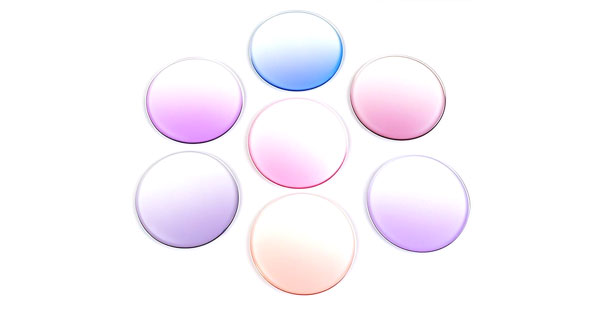Spectacle lens coloring technology: application analysis of pigments and dyes
28 Mar 2025
In the field of spectacle lens manufacturing, the selection of pigments and dyes directly affects the optical performance, durability and safety of the product. This article will introduce the characteristics and applications of these two types of colorants in detail.
1. The basic difference between pigments and dyes
1.1 Dyes characteristics
Dyes are soluble in resins or solvents to form a transparent or translucent color layer. Its main features include: high color uniformity, excellent light transmittance, suitable for making gradient effects, and commonly used in fashionable sunglasses and lightly tinted lenses.
However, dyes also have the disadvantage of poor light resistance, and long-term ultraviolet exposure may cause fading.

1.2 Pigments characteristics
Pigments are dispersed in the lens material in the form of particles. The main features include: excellent light resistance, strong color stability, suitable for dark and high-saturation lenses, and widely used in sports glasses and industrial protective glasses
Pigments may affect light transmittance, so they are not suitable for high-precision optical lenses.
 2. Main types of colorants and their applications
2.1 Common types of dyes
Azo dyes: provide a spectrum from bright yellow to dark red
Anthraquinone dyes: particularly suitable for blue-green tones
Azomethine dyes: have excellent weather resistance
Dye selection needs to consider the polarity of the resin substrate. For example, CR-39 resin is more suitable for dyes with stronger polarity, otherwise uneven coloring is prone to occur.
2.2 Common types of pigments
Iron oxide series: the main choice for red, yellow and brown tones
Titanium dioxide: has both coloring and light stabilization functions
Carbon black: a black colorant that requires strict control of particle size
Experimental data show that high-quality pigments have a 15-20% higher UV blocking rate than ordinary dyes.
3. Functional coloring technology
3.1 Photochromic system
High-quality photochromic lenses usually use a composite dye system, including:
1. Photosensitive dyes (such as naphthopyrans)
2. Main types of colorants and their applications
2.1 Common types of dyes
Azo dyes: provide a spectrum from bright yellow to dark red
Anthraquinone dyes: particularly suitable for blue-green tones
Azomethine dyes: have excellent weather resistance
Dye selection needs to consider the polarity of the resin substrate. For example, CR-39 resin is more suitable for dyes with stronger polarity, otherwise uneven coloring is prone to occur.
2.2 Common types of pigments
Iron oxide series: the main choice for red, yellow and brown tones
Titanium dioxide: has both coloring and light stabilization functions
Carbon black: a black colorant that requires strict control of particle size
Experimental data show that high-quality pigments have a 15-20% higher UV blocking rate than ordinary dyes.
3. Functional coloring technology
3.1 Photochromic system
High-quality photochromic lenses usually use a composite dye system, including:
1. Photosensitive dyes (such as naphthopyrans)
2. Photochromic pigments (iSuoChem has launched photochromic pigments with very high transparency, which are specially used for the production of lenses. They will change color under sunlight)

3. Light stabilizer
4. Auxiliary color developer
3.2 Polarization technology
True polarized lenses use directional dichroic dyes that can selectively transmit light in a specific direction.
4. Colorant selection criteria
High-quality lens colorants should meet the following requirements:
Optical purity: no impact on image quality
Weather resistance: pass 500-hour xenon lamp aging test
Physiological safety: meet ISO ocular safety standards
Process stability: batch color difference ΔE <1.5
Environmental requirements: no restricted substances such as heavy metals
5. Industry development trends
The main challenges in the current lens tinting field:
Difficulties in tinting high refractive index materials
Improving color change response speed
Developing environmentally friendly colorants
Manufacturers are advised to:
Establish a complete colorant evaluation system
Strengthen technical cooperation with raw material suppliers
Pay attention to color quality control
Lens tinting is not only an aesthetic issue, but also an important engineering technology related to visual health. With the advancement of materials science, more innovative tinting solutions will emerge in the future.

